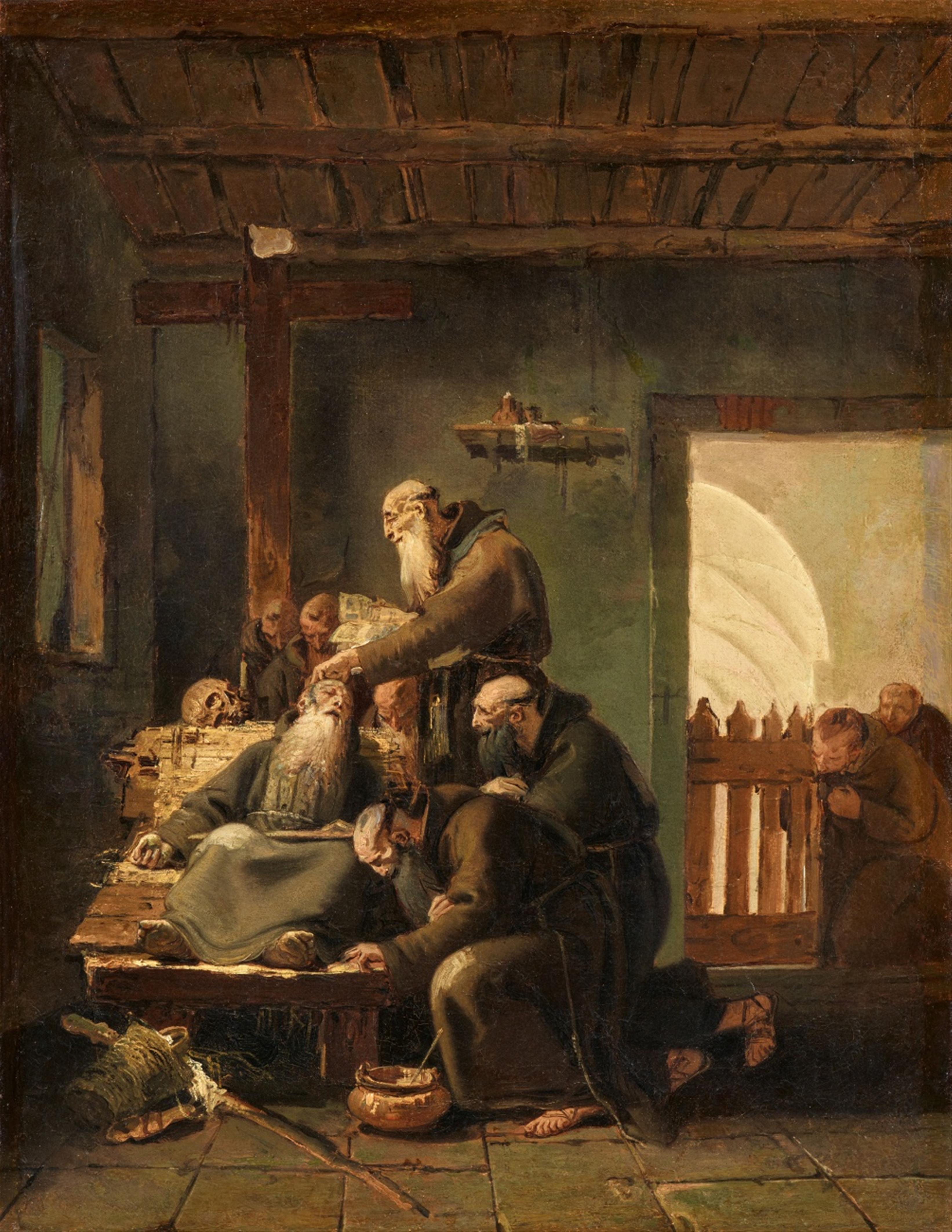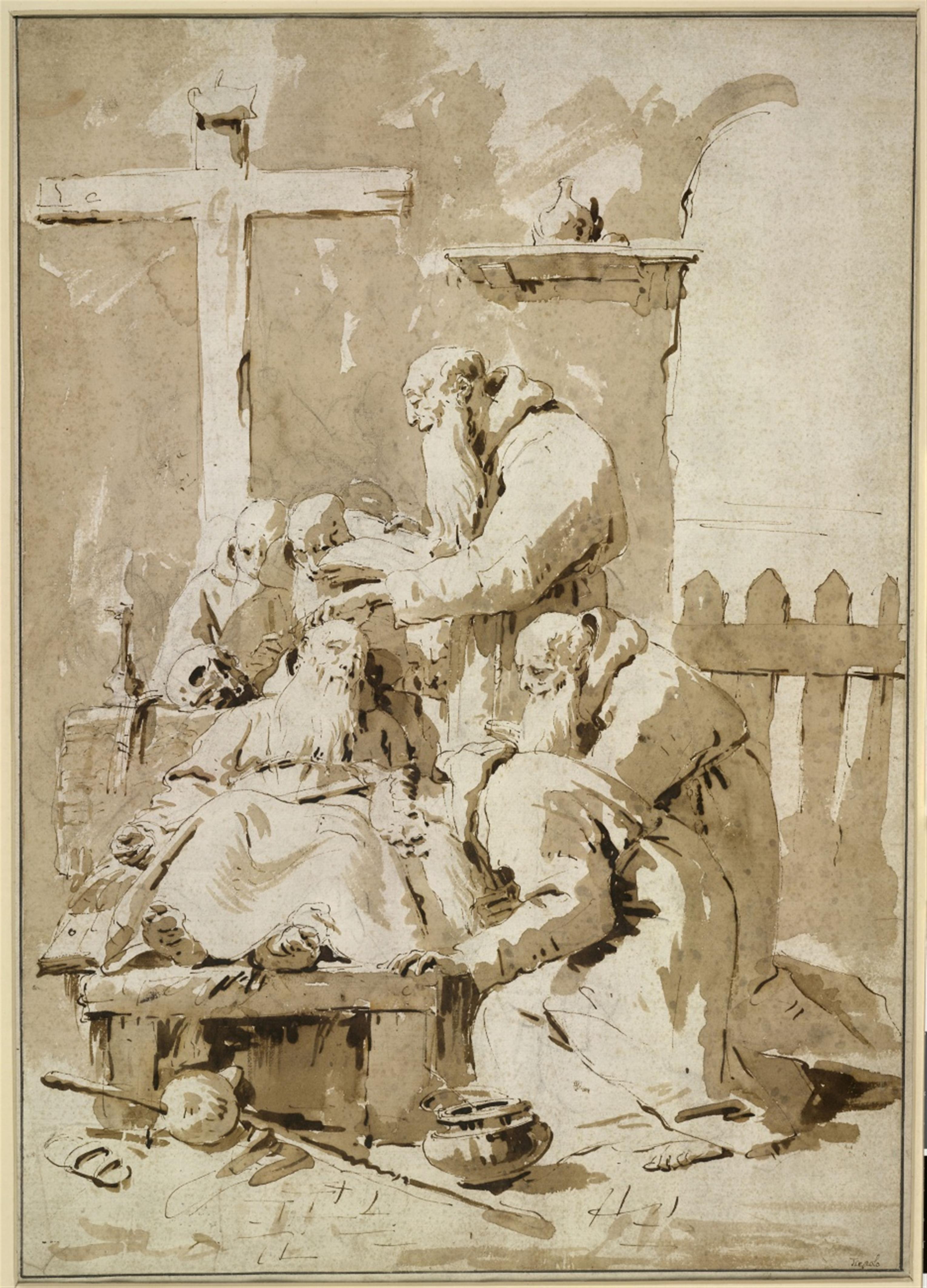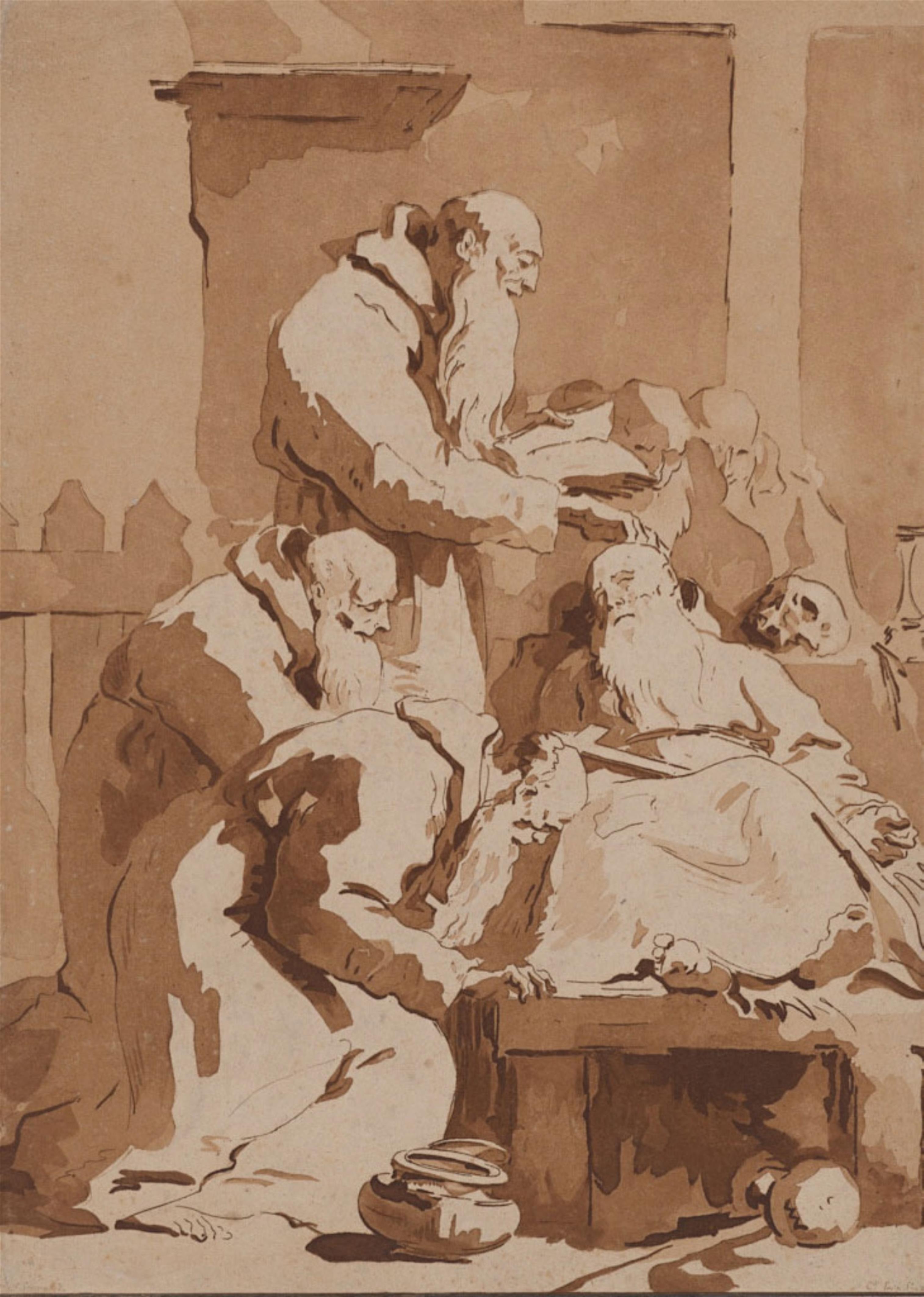Giovanni Battista Tiepolo
Interior Scene with Capuchin Monks at the Deathbed of a Brother
Oil on canvas (relined). 56 x 42 cm.
This is an unusual subject for Giovanni Battista Tiepolo: A Capuchin monk on his deathbed accompanied by six friars in a monastery cell. The colour palette of the painting, consisting of a rich accord of different shades of brown, is equally unusual. Brown is the colour of the cowl of the Capuchin monks, a mendicant order committed to poverty, whose church in Venice is Palladio's "Il Redentore". But in its sketchy immediacy, in the way the subject is captured with rapid and virtuoso brushstrokes, the hand of the great Venetian Settecento master is immediately recognizable, also in the lively, flickering use of light in this intimate scene.
The provenance of the painting can be traced back to its inception. In 1776 it is already mentioned in the inventory of Count Bonomo Corniani Algarotti, the brother and heir of Count Francesco Algarotti, who had commissioned the work about twenty years earlier. Algarotti, one of the dazzling intellectuals of the 18th century, a friend of Voltaire and others, and the most important art agent of the Elector August III of Saxony, was in contact with the most important artists of his time - not only in Venice, but primarily there. We know that he was personally acquainted with Giovanni Battista Tiepolo as it is recorded in his diaries and letters.
What is not known are the circumstances of the picture's creation and why this subject was chosen. There is evidence that Algarotti admired the works of Alessandro Magnasco, with his surreal depictions of monastic life. Could it have been that he expressly requested such a depiction from Tiepolo? Or did Tiepolo create such a work of his own accord? We do not know. However, since Tiepolo had long been celebrated as the greatest painter in Venice, it is rather unlikely that he did not create this painting for the count of his own accord.
There is also a certain ambiguity concerning the date at which it was painted. Morassi, Martini, Gemin, and Pedrocco dated the painting to the period from 1733 to around 1740; if Algarotti commissioned the work after Magnasco's death in 1749, it could have been painted after Tiepolo's return from Würzburg in 1753.
Tiepolo died in Madrid in 1761. In the same year, Jean Honoré Fragonard stayed in Venice and drew a copy of this painting (P. Rosenberg, op. cit.). That work was once housed in the collection of Pierre-Jean Mariette but its whereabouts are unknown today. However, its composition is recorded in an aquatint etching by Claude Jean Baptiste Hoin from 1796/97 (see A. Ananoff: L'oevre dessiné de Jean-Honoré Fragonard, Paris 1961-1971, vol. IV, no. 459, fig. 696).
The link between Tiepolo and Fragonard in this case was probably Francesco Algarotti himself, who in those years wrote an essay in support of the French Academy in Rome, of which Fragonard was the leading member at the time.
After 1764, the painting came into the property of Francesco's brother, Bonomo Algarotti, and after his death it passed to his daughter Maria Algarotti, wife of Marino Corniani. The inscription on the original canvas, now glued to the centre on the stretcher, refers to its sale.
From the Corniani Algarotti family the painting passed to Lord George Cavendish-Bentnick (1821-1891), the passionate art lover and trustee of the British Museum. He loved Venice and Venetian art and owned a remarkable art collection in his London home on Graftons Street, which was auctioned at Christie's in London on July 11th 1891. This masterpiece by Giovanni Battista Tiepolo also changed hands there.
Provenance
The collection of Francesco Algarotti (1712-1764). - The collection of Count Bonomo Corniani Algarotti (died 1776). - The collection of Countess Maria Algarotti Corniani. - The collection of Lauro Bernardino Corniani Algarotti. - The collection of George Augustus Frederick Cavendish-Bentninck, Trustee of the British Museum (1821-1891), London (label on the verso). - His sale Christie, Manson & Woods, 8th -13th July 1891, p. 83, lot 775. - E. Bromley Martin. - His sale 28th March 1924, Lot 117. - Private collection Italy.
Literature
Gianantonio Selva or Bonomo Algarotti(?), Catalogo dei quadri, dei disegni e dei libri che trattano dell’arte del disegno della galleria del fu Sig. Conte Algarotti in Venezia, Venice 1776, p. XXIV. - Lauro Bernardino Corniani de’ Conti d’Algarotti, Galleria particolare: catalogo de’ dipinti ed oggetti d’arte posseduti dal nobile signor Lauro Bernardino Corniani de’ conti d’Algarotti antico conservatore dell’I. R. Accademia di belle arti di Venezia, Venice 1854, cat. 60. - Catalogue of the highly important collection of ancient & modern pictures: objects of art, decorative furniture, and old English & foreign silver and silver-gilt plate, of the late Rt. Hon. G.A.F. Cavendish Bentinck: which ... will be sold by auction, by Messrs. Christie, Manson & Woods ... on Wednesday, July 8, 1891 and three following days, and on Monday, July 13, 1891, and following day, p. 83, lot 775. - E. Sack, Giambattista Tiepolo, Hamburg 1910, p. 231, cat. 581. - A. E. Popham, A Drawing by Giovanni Battista Tiepolo, in “British Museum Quarterly”, 9, No. 4 (May 1935), p. 103. - Loan Exhibition of Paintings, drawings and prints by the two Tiepolos, The Art Institute of Chicago, 1938, p. 17, cat. 1, note 2. - M. Levy, Two Paintings by Tiepolo from the Algarotti Collection, in “The Burlington Magazine”, June 1960, no. 687, vol. 102, p. 257, n. 6. – A. Morassi, A Complete Catalogue of the Paintings of G.B. Tiepolo, including pictures by his pupils and followers wrongly attributed to him, London 1962, p. 18, fig. 136. - E. Martini, La pittura veneziana del Settecento, Venice 1964, pp. 60, 202, note 136. - M. Gemin, F. Pedrocco, Giambattista Tiepolo. I dipinti, Venice 1993, p. 296, cat. 159. - M. Valleès-Bled, in Peintres de Venise de Titien à Canaletto dans le collections italiennes, Exhibition Catalogue, Musée de Lodève, 2000, Milan 2000, pp. 94-95, cat. 40. - P. Rosenberg, Un tableau de Tiepolo, un dessin de Fragonard, Algarotti et Mariette, in Per l’arte da Venezia all’Europa. Studi in onore di Giuseppe Maria Pilo, edited by M. Piantoni, L. De Rossi, Venice 2001, vol. II: Da Rubens al contemporaneo, pp. 469-470, tav. XLIV. - F. Arisi, Dipinti piacentini di Fra’ Stefano da Carpi, in “Strenna piacentina”, 2001, p. 143, fig. 108, p. 146. - A. Tempestini, F. Weiland-Pollerberg, in M. Brunner, C. Theil: Venezianische Malerei von 1500 bis 1800. Kontour oder Kolorit? Ein Wettstreit schreibt Geschichte, Exhibition catalogue Städtisches Museum Engen + Galerie 2003, p. 15, fig. 3, pp. 144-145. - A. Magnani, in F. Caroli, Il gran teatro del Mondo. L’anima ed il volto del Settecento, Exhibition catalogue, edited by F. Caroli, Milan 2003 pp. 590-591, cat. II.162. - A. Cottino, in A. Busto, A. Cottino, F. Poli (edited by), Chronos. Il tempo nell'arte dall’epoca barocca all’età contemporanea, Exhibition catalogue, Caraglio 2005, pp. 504-505. - T. Scarpa, Gli Angeli sono persone qualunque. Memorie di una volontaria, Venice 2005, pp. 80-81. - F. Minervino, J. Scarpa, S. Kato, Giambattista Tiepolo, Il transito del cappuccino, in Pittura a Venezia da Tiziano a Longhi, Exhibition Catalogue, Shizuoka Prefectural Museum of Art; Oita: Oita Art Museum; Tokyo: Bunkamura The Museum; Tottori Prefectural Museum, Japan 2007, pp. 72-73, 211, cat. 33, Italian translation: pp. 20, 34. - J. Scarpa, in S. Scarpa (edited by), Da Tiepolo a Guardi, La pittura di figura nel ‘700 veneziano, Exhibition catalogue, Belluno 2010, with contributions of G. Knox, F. Pedrocco, M. Vallés-Bled, F. Brunner et al., pp. 72-73. – A. Craievich, Giambattista Tiepolo, La morte del cappuccino, in Giambattista Tiepolo: il Miglior Pittore di Venezia, Exhibition catalogue, Passariano 2012, ed. G. Bergamini, A. Craievich, F. Pedrocco, p. 112, fig. 27, p. 234, cat. 27.
Exhibitions
Mexico City: Museo Dolores Olmedo Patiño, 2002. - Engen: Städtisches Museum Engen, 2003. - Milan, Palazzo Reale, 2003/2004. - Caraglio 2005. – Toyota: Municipal Museum of Art, Shizuoka: Shizuoka Prefectural Museum of Art, Oita: Oita Art Museum, Tokyo: Bunkamura The Museum, Tottori: Tottori Prefectural Museum 2007. - Passariano, Villa Manin, 2012/2013.






